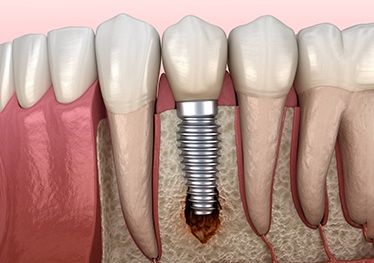
Dental Implant Failure & Salvage – Garland, TX
Save Your Restored Smile

Dental implants are predictably successful. They do well in more than 95% of cases, so you have plenty of reason to expect your new teeth to stand the test of time. However, there is always the slight risk that something will go wrong. If you ever notice problems with your prosthetics, get in touch with our Garland office. We will assess the situation and strive to save your restored smile with our dental implant salvage services.
Why Do Dental Implants Fail?

The most common reason for dental implant failure is an infection that invades the tissue around an implant. Eventually, it can cause so much damage that the implant no longer has a strong base of support. This infection, called peri-implantitis, is often the result of poor oral hygiene, though other factors can certainly contribute to it.
Other possible reasons for dental implant failure include:
- Medical conditions, including some types of cancer and diseases that compromise the immune system.
- Physical trauma, such as an accident or extended teeth grinding and clenching.
- Failed osseointegration, a problem wherein the implants do not bond properly with the surrounding tissues.
Symptoms of a Failed Dental Implant

Dental implant failure can occur at any time, even years or decades after the initial placement surgery. Therefore, you should always be on the lookout for signs of dental implant failure. Here are some reasons to book an appointment with our team ASAP:
- Unusual pain. After you heal from the dental implant treatment process, you should enjoy pain-free function from your new teeth. Discomfort is a reason to seek professional care.
- Difficulty eating. Your implants should enable you to eat virtually any food without trouble. Challenges in this area indicate that something is wrong.
- Signs of infection. Pus, swelling, redness, and receding gums are all possible indications of peri-implantitis.
- A loose-feeling implant. If an implant feels loose, it could mean there is a problem with your restoration (crown, bridge, or denture). It is also possible that there is a problem with the implant itself.
How Dental Implant Salvage Works

Contact us to book an appointment as soon as you notice that something is not right with your implants. The sooner you receive care, the more likely it is that your implant can be saved without extensive or invasive measures.
When you come to see us, we will examine your mouth and possibly use our CBCT machine to understand what is happening beneath your gumline. After that, we will be able to formulate a treatment plan. In some cases, something as simple as changes to a patient’s oral hygiene routine or some prescription mouthwash might be all that is necessary. In other instances, it might be necessary to removing a failing implant. Later, after a healing period and a possible bone graft, it may be possible to place a new implant.